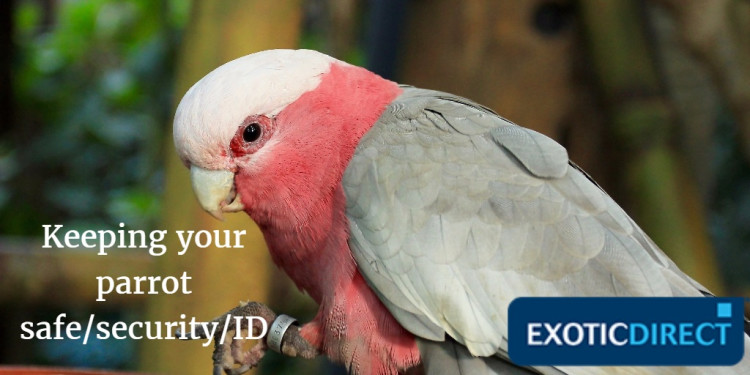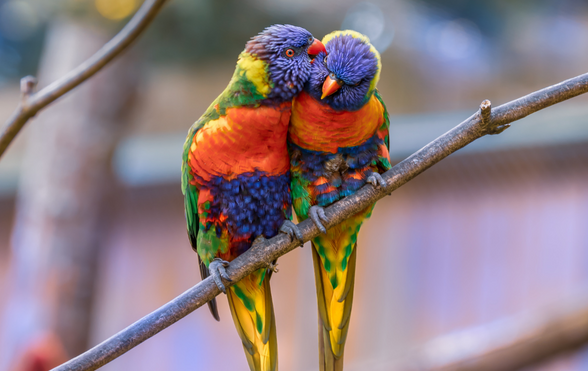The summer months can present challenges for parrot owners, as birds may escape out of open doors and windows. Securing windows and doors and ensuring your bird is fully identifiable should it escape, is essential.
Is your parrot insured? Get a quote for up to £5,000 of vet fee cover, death and theft cover | We’ve been insuring exotic pets since 1996 | Check out our customer reviews on Feefo.
Table of contents: How can I prevent a parrot escape? | How can I keep my parrot secure? Identification methods | Why should I get my parrot microchipped? | Does microchipping hurt the parrot? | How much does microchipping cost? | How to read a parrot’s leg band | Should you clip your parrot’s wings? | The Parrot Passport
How can I prevent a parrot escape?
To help prevent your parrot from escaping from your house, when she’s not in her cage, you should:
- Ensure all windows are closed
- Ensure your patio or back door is closed
- For ventilation you can secure blinds or mesh against the window
- Let visitors know that your parrot may be out of his cage.
- Don’t be distracted by nice weather, family members or visitors. Your parrot is quick, and can fly out of any opening when your back is turned. A lapse in your concentration could lead to a lost bird. Your bird’s security is down to you.
Birds are escape artists, and can leave behind a devastated owner if they escape. African Grey’s especially are known as the “the great Houdinis” of the parrot world.
Ensuring your parrot is trained can also help in keeping her safe and secure. Making things less stressful for you and her.
Parrot expert Dorothy Schwarz has written an article on Positive Reinforcement that you may like to read.
How can I keep my parrot secure? Identification methods
- Microchipping
- Closed bands (rings)
- Split bands (rings)
- DNA profiling
- Microchipping
- Photography
You should ensure your parrot is positively identifiable especially as they are the most vulnerable to theft and escape.
Positive identification can be essential in proving legal ownership should your bird be lost.
There’s nothing worse than knowing the parrot is yours, and she knows you’re her parent, but you can’t prove it. Especially if your parrot’s been stolen, and you need to prove ownership, or if she’s been found by someone who does not want to return her.
You may like to read Dorothy Schwarz article on Biting and feather plucking in parrots
It’s recommended by many experts that you get your parrot microchipped. You can get this done by a specialist avian vet.
Why should I get my parrot microchipped?
A microchip can help provide irrefutable evidence that the bird is yours should it be lost or stolen. Thieves can remove rings; however it’s unlikely they would attempt to remove a microchip!
Is your parrot insured? Get a quote for up to £5,000 of vet fee cover, death and theft cover | We’ve been insuring exotic pets since 1996 | Check out our customer reviews on Feefo.
Alternatively you can call us on 0345 982 5505
John Hayward of the National Theft Register has heard of cases where thieves have removed rings, but he has not heard of cases where microchips have been removed.
Like with dogs and cats, microchipping provides a lifetime record of pet ownership. And like with dogs and cats, you should ensure the register is kept up to date if you decide to sell your bird. You can contact your vet about this, who should be able to help.
Microchipping is also a recommended method of permanent identification if you own a CITES listed bird. African Grey and Timneh Grey parrots have now been added to Annex A of CITES. You should also ensure you provide a relevant Article 10 Certificate if you’re selling a CITIES listed bird.
Does microchipping hurt the parrot?
Microchipping shouldn’t hurt your bird, and now with the new mini microchip it can also be used for smaller birds such as parakeets.
Microchipping should always be done by a specialist avian vet.
If you’d like to find out more about microchipping your bird you can contact the National Theft Register or the Parrot Society.
How much does microchipping cost?
Microchipping can cost between £39 – £42 using a mini microchip.
Pricing was based on CJ Hall and Anton Vets pricing (2017) who specialise in treating exotics.
However prices will vary depending on veterinary practice. To find an exact price, you should consult your specialist vet. If you don’t have a specialist vet you can find a vet here.

What leg bands (rings) can you fit to your parrot?
There are two types of leg bands also known as rings that you can fit to your bird:
Closed rings for birds – A closed leg band (or ring) displays a unique ID inscription, and is fitted to a parrot as a young chick. A closed leg band cannot be slipped off when the bird grows into it. The inscription should include breeder’s initials, year of birth and certified number for the year linking it to a birth/hatch certificate copy of which is passed to new owner.
A closed ring can be essential when applying for CITES licences as it can be presumed that the bird must have been captive bred and not taken from the wild.
Split rings for birds – These are fitted to birds when they’re a little older. Unfortunately split rings can easily be removed by thieves, and they can catch on aviary mesh.
They’re also not an acceptable form of ID for CITES article 10 licences.
A recent case involving a ringed bird, was of an African Grey lost in South London. The bird was fitted with a Parrot Society closed ring which proved its true ownership. Both bird and owner were subsequently reunited.
How to read a parrot’s leg band
Reading a parrot’s ring or leg band should be accompanied with gentle and careful approach.
John Hayward recommends you wrap the bird in a light cloth, covering its head and exposing the relevant foot.
You should should read the ring details out loud to a third person who will record the inscription and prevent it being repeated to reduce any stress caused.
What is DNA profiling for birds?
DNA profiling services can be provided by specialist avian biotech companies by submitting a blood sample. This procedure is for the lifetime of the bird.
What is wing clipping?
Wing clipping, also referred to as feather clipping, involves clipping a bird’s flying feathers to prevent it from gaining full flight.
Does wing clipping hurt a bird?
No, it shouldn’t hurt the bird physically if done correctly by a professional. However, it could harm your bird psychologically, due to the frustration of not being able to fly (which is their natural instinct). This could lead to behavioural problems such as feather plucking.
Should you clip your parrot’s wings?
ExoticDirect and John Hayward do not recommend that you clip your parrot’s wings.
Also, wing clipping should not be considered a permanent method of flight restraint as feathers do grow back. John Hayward on behalf of the National Theft Register states that 50% of lost birds have had their wings clipped at some stage.
One case of a lost bird involved an escaped bird who had been wing clipped. The bird was later found in a tree outside the owner’s house.
Who can carry out wing clipping on my bird?
Wing clipping should only be carried out by a specialist avian vet or trained nurse or another competent person for example a breeder with a lot of experience.
You should never attempt to clip your parrots wings yourself. You could cause significant injury to your bird, both physically psychologically.
Photographing parrots for identification
Photography is another vital means of identification. Photograph the whole bird and any unique features, for example a twisted beak, missing toes, unusual plumage and so on.
You should take photographs annually, sign and date the images and store in a secure place if ever required for identification.
The Parrot PassportThe Parrot Passport contrary to its name, doesn’t allow your parrot to travel. Instead it’s a great little document that been designed by John Hayward for the National Theft Register and the Parrot Society. It allows you to document all identification information for your bird. It means that you’ve got all your essential information about your parrot in one place.
You can download it here. Alternatively you can obtain it from the Parrot Society.
With thanks to John Hayward who runs the National Theft Register for exotic animals for his contribution to this article. John Hayward runs the National Theft Register. If you have any security concerns about your bird, or if you’ve lost your bird, you can contact him at jh@ntr.supanet.com or call him on: 01869 325699.
Is your parrot insured? Get a quote for up to £5,000 of vet fee cover, death and theft cover | We’ve been insuring exotic pets since 1996 | Check out our customer reviews on Feefo.
Own a cat or dog? Get pet insurance that covers up to £12,000 for dogs and £9,000 for cats in vet fees every year, including dental for illness and accidents with British Pet Insurance.

